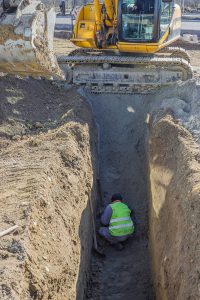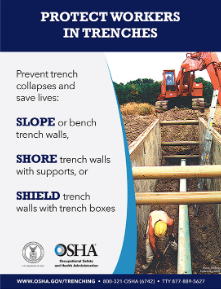New Jersey Trench & Excavation Accident Lawyer
Fighting for New Jersey Trench & Excavation Accident Victims
 In 2018, 28-year old construction worker Jason Holmes suffocated and died in a trench collapse at a Michigan excavation site. There were no proper safety precautions such as sloping or shoring of the trench walls. There was nothing in the trench to protect Jason until rescuers could reach him. Tooma Entreprises, the construction company responsible for Jason’s death was fined $35,000 for five violations of Michigan safety standards. Tooma contested the violations and proposed fine.
In 2018, 28-year old construction worker Jason Holmes suffocated and died in a trench collapse at a Michigan excavation site. There were no proper safety precautions such as sloping or shoring of the trench walls. There was nothing in the trench to protect Jason until rescuers could reach him. Tooma Entreprises, the construction company responsible for Jason’s death was fined $35,000 for five violations of Michigan safety standards. Tooma contested the violations and proposed fine.
Excavation-related fatalities are 112 percent higher than general construction fatalities according to OSHA data. Excavation sites and trenches are inherently unstable; collapses and flooding can occur in seconds. Being buried under one cubic yard of soil is equivalent in weight to being buried under a small car. Due to the alarming increase in trench and excavation fatalities, the U.S. Department of Labor has made a 10% reduction of excavation hazards by September 2019 an agency priority.
“Before you open up a trench, nature is in balance. As soon as you cut into it, the earth wants to heal itself by caving in,”–David Dow, senior vice president TrenchSafety and Supply
In the National Association of Safety April 2019 newsletter, Joe Turner, director of engineering, research and product development identified two primary causes of serious injuries and fatalities in excavation work: “Either where there’s no shoring at all,” he said, “or where the contractor misapplies the shoring system – doesn’t do it properly, doesn’t do a job hazard analysis before they begin the shoring, that sort of thing.”
General contractors and construction site managers are required by OSHA to ensure that all trenching and excavating is done with all precautions and safety measures in place to prevent accidents and injuries to workers. Most, if not all trench and excavation accidents are preventable.
However, some construction companies make deliberate decisions not to protect excavation workers because protection costs money. Some simply do not want to take the time to install trench protections specific to the trench’s soil and other environmental conditions.
There are four types of trench collapses are the:
- Spoil Slide occurs when the dirt that is removed from the trench is piled too close to the trench itself. The dirt can back into the hole and crush any workers below.
- Shear Wall Collapse happens when the top portion of the newly carved-out wall collapses. This can push an average of two to three yards of soil –weighing nearly 9,000 pounds onto a worker.
- Belly Slough–similar to a shear wall collapse however the middle portion of the wall collapses rather than the top. Belly sloughs usually occur in areas around underground utilities or where running water is present.
- Lip Slide is also similar to a shear wall collapse, however it is considered to be less serious. This is because only a portion of the top wa
ll collapses onto the worker. Lip slides occur when the spoil pile is too close to the trench, causing the upper portion of the newly formed wall to collapse.
All employers and workers must be aware of the methods that should be taken to ensure the safety of trenches and excavations. There are four techniques used to make trenches safe and prevent accidents, injuries, and lawsuits. They are: Sloping, Shoring and Shielding

Sloping is when the walls of the hole are carved out on a slope preventing any type of collapse from the top. Benching is a form of sloping that involves carving out a series of horizontal steps with vertical or near-vertical surfaces between levels.
Shoring consists of installing panels against the trench walls. The panels are held in place by a hydraulic pump– making a collapse highly unlikely because the soil on both sides is held back.
Shielding is another way to keep dirt from collapsing into a trench. The shield is made from two heavy pieces of steel or aluminum forming a skeleton-like structure that is placed inside the trench. This holds back the dirt from both sides and maintains stability and safety for the workers in the environment.
Construction Workers S
afe Workplace Rights Under the Law
All construction workers are entitled under federal law to a safe workplace. This includes being provided with safety gear, working on or with safe machinery and getting proper training. You have the right to speak up if you see or experience an unsafe condition on the job without fear of retaliation.
If you or someone you know has been involved in a trench or excavation collapse, contact our experienced accident and injury lawyers at Keefe Law Firm. We can help you understand your rights under the law and get compensated for injuries caused by an employer’s negligence.